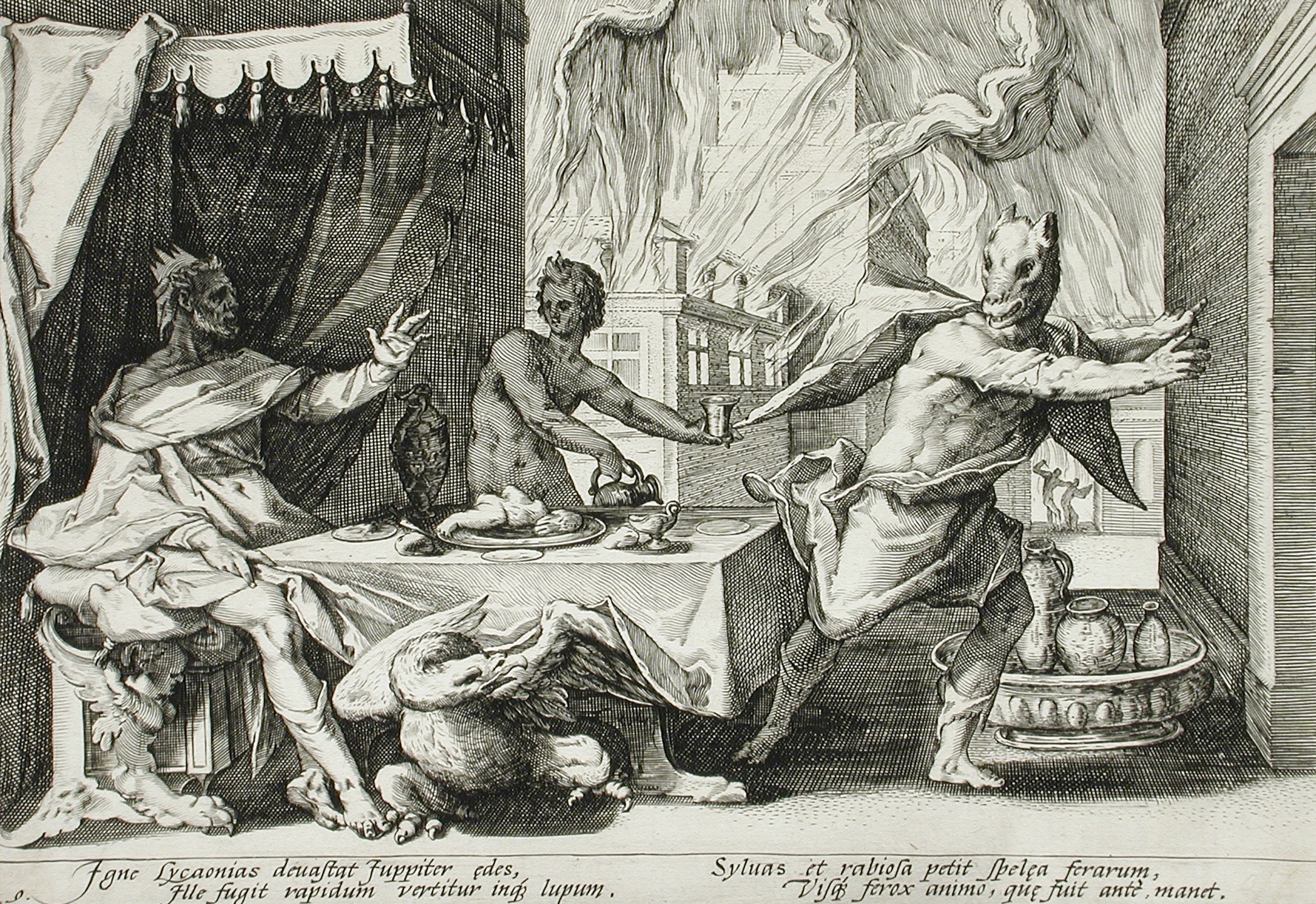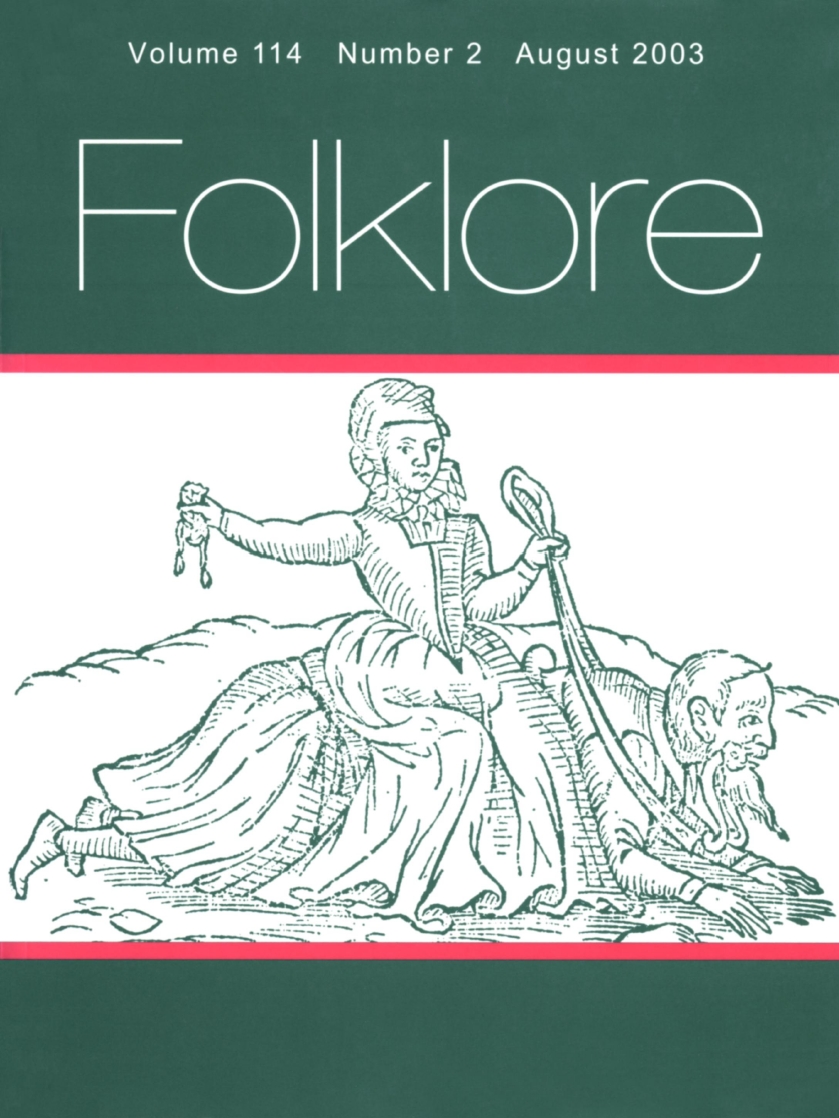|
Werewolves
In folklore, a werewolf (), or occasionally lycanthrope (from Ancient Greek ), is an individual who can shapeshift into a wolf, or especially in modern film, a therianthropic hybrid wolf–humanlike creature, either purposely or after being placed under a curse or affliction, often a bite or the occasional scratch from another werewolf, with the transformations occurring on the night of a full moon. Early sources for belief in this ability or affliction, called lycanthropy, are Petronius (27–66) and Gervase of Tilbury (1150–1228). The werewolf is a widespread concept in European folklore, existing in many variants, which are related by a common development of a Christian interpretation of underlying European folklore developed during the Middle Ages. From the early modern period, werewolf beliefs spread to the New World with colonialism. Belief in werewolves developed in parallel to the belief in witches during the late Middle Ages and the early modern period. ... [...More Info...] [...Related Items...] OR: [Wikipedia] [Google] [Baidu] |
Werewolf Fiction
Werewolf fiction denotes the portrayal of werewolves and other shapeshifting therianthropes, in the media of literature, drama, film, games and music. Werewolf literature includes folklore, legend, saga, fairy tales, Gothic and horror fiction, fantasy fiction and poetry. Such stories may be supernatural, symbolic or allegorical. A classic cinematic example of the theme is '' The Wolf Man'' (1941) which in later films joins with the Frankenstein Monster and Count Dracula as one of the three famous icons of modern day horror. However, werewolf fiction is an exceptionally diverse genre, with ancient folkloric roots and manifold modern re-interpretations. Literary origins In Greek mythology, there is a story of an Arcadian King called Lycaon who tested Zeus by serving him a dish of his slaughtered and dismembered son to see if Zeus was really all-knowing. As punishment for his trickery, Zeus transformed Lycaon into a wolf and killed his 50 sons by lightning bolts, but supposedl ... [...More Info...] [...Related Items...] OR: [Wikipedia] [Google] [Baidu] |
Werewolf Witch Trials
Werewolf witch trials were witch trials combined with werewolf trials. Belief in werewolves developed parallel to the belief in European witchcraft, witches, in the course of the Late Middle Ages and the Early Modern period. Like the witchcraft trials as a whole, the trial of supposed werewolves emerged in what is now Switzerland (especially the Valais and Vaud) during the Valais witch trials in the early 15th century and spread throughout Europe in the 16th, peaking in the 17th and subsiding by the 18th century. The persecution of werewolves and the associated folklore is an integral part of the "witch-hunt" phenomenon, albeit a marginal one, accusations of lycanthropy involved in only a small fraction of witchcraft trials. During the early period, accusations of lycanthropy (transformation into a wolf) were mixed with accusations of wolf-riding or Wolfssegen, wolf-charming. The 1589 case of Peter Stumpp led to a significant peak in both interest in and persecution of supposed we ... [...More Info...] [...Related Items...] OR: [Wikipedia] [Google] [Baidu] |
Gothic Horror
Gothic fiction, sometimes referred to as Gothic horror (primarily in the 20th century), is a literary aesthetic of fear and haunting. The name of the genre is derived from the Renaissance era use of the word "gothic", as a pejorative to mean medieval and barbaric, which itself originated from Gothic architecture and in turn the Goths. The first work to be labelled as Gothic was Horace Walpole's 1764 novel ''The Castle of Otranto'', later subtitled ''A Gothic Story''. Subsequent 18th-century contributors included Clara Reeve, Ann Radcliffe, William Thomas Beckford, and Matthew Lewis. The Gothic influence continued into the early 19th century, with Romantic works by poets, like Samuel Taylor Coleridge and Lord Byron. Novelists such as Mary Shelley, Charles Maturin, Walter Scott and E. T. A. Hoffmann frequently drew upon gothic motifs in their works as well. Gothic aesthetics continued to be used throughout the early Victorian period in novels by Charles Dickens, Brontë si ... [...More Info...] [...Related Items...] OR: [Wikipedia] [Google] [Baidu] |
Shapeshifting
In mythology, folklore and speculative fiction, shapeshifting is the ability to physically transform oneself through unnatural means. The idea of shapeshifting is found in the oldest forms of totemism and shamanism, as well as the oldest existent literature and Epic poetry, epic poems such as the ''Epic of Gilgamesh'' and the ''Iliad''. The concept remains a common literary device in modern fantasy, children's literature and popular culture. Examples of shapeshifters are vampires and werewolves. Folklore and mythology Popular shapeshifting creatures in folklore are werewolf, werewolves and vampires (mostly of European, Canadian, and Native American/early American origin), ichchhadhari naag (shape-shifting cobra) of India, shapeshifting fox spirits of East Asia such as the huli jing of China, the obake of Japan, the Navajo skin-walkers, and gods, goddesses and demons and demonesses such as the Norse mythology, Norse Loki or the Greek mythology, Greek Proteus. Shapeshifting to th ... [...More Info...] [...Related Items...] OR: [Wikipedia] [Google] [Baidu] |
Peter Stumpp
Peter Stumpp (–1589; name is also spelt as Peter Stube, Peter Stubbe, Peter Stübbe or Peter Stumpf) was a German farmer and alleged serial killer, accused of werewolfery, witchcraft, and cannibalism. He was known as "the Werewolf of Bedburg". Sources The most comprehensive source on the case is a 16-page pamphlet published in London in 1590, the translation of a German print of which no copies have survived. The English pamphlet, of which two copies exist (one in the British Museum and one in the Lambeth Library), was rediscovered by occultist Montague Summers in 1920. It describes Stumpp's life, his alleged crimes, and the trial, and includes many statements from neighbours and witnesses on the crimes. Summers reprints the entire pamphlet, including a woodcut, on pages 253 to 259 of his work ''The Werewolf''. Additional information is provided by the diaries of Hermann von Weinsberg, a Cologne alderman, and by a number of illustrated broadsheets, which were printed i ... [...More Info...] [...Related Items...] OR: [Wikipedia] [Google] [Baidu] |
Wolfssegen
In Bavarian folklore of the Early Modern period, a ''Wolfssegen'' (; also ''Wolfsegen, Wolf-Segen'') was an apotropaic charm against wolves; conversely, a ''Wolfbann'' (''Wolf-Bann'') was a malevolent spell causing a wolf attack. The ''Wolfssegen'' is just one specific example of various distinct kinds of '' Segen'' ("blessing; charm, incantation") in the folklore of German-speaking Europe. Early examples of ''Wolfssegen'' survive from the Late Middle Ages. The use of these charms seems to have peaked during the 17th century, when they were offered by professional "wolf charmers" (''Wolfssegner'' or ''Wolfbanner''). This corresponds to the cold period known as the Little Ice Age, for which there is ample historical evidence of wolf populations in much of the Bavarian Alps. There is no extant text of a ''Wolfbann'', the malevolent opposite of the ''Wolfsegen''. However, there is the text of a spell ''reversing'' a ''Wolfbann'' recorded in 1635, in effect again a ''Wolfsegen'', ... [...More Info...] [...Related Items...] OR: [Wikipedia] [Google] [Baidu] |
Skinwalker
In Navajo culture, a skin-walker () is a type of Black magic, harmful Witch (Navajo), witch who has the ability to Shapeshifting, turn into, possess, or disguise themselves as an animal. The term is never used for healers. The yee naaldlooshii, translating to "by means of it, it goes on all fours", is one of several types of skin-walkers within Navajo beliefs. These witches are seen as the antithesis of Navajo values, performing malevolent ceremonies and using manipulative Magic (supernatural), magic in stark contrast to the beneficial works of medicine people. The legend of skin-walkers is deeply embedded in Navajo tradition and rarely discussed with outsiders. This reticence is partly due to cultural taboos and the lack of contextual understanding by non-Navajos. Stories often depict skin-walkers using their powers for evil, and they are considered a source of fear and mystery within Navajo communities. Traditional accounts describe them as powerful Sorcerer (supernatural), so ... [...More Info...] [...Related Items...] OR: [Wikipedia] [Google] [Baidu] |
Early Modern Period
The early modern period is a Periodization, historical period that is defined either as part of or as immediately preceding the modern period, with divisions based primarily on the history of Europe and the broader concept of modernity. There is no exact date that marks the beginning or end of the period and its extent may vary depending on the area of history being studied. In general, the early modern period is considered to have lasted from around the start of the 16th century to the start of the 19th century (about 1500–1800). In a European context, it is defined as the period following the Middle Ages and preceding the advent of modernity; but the dates of these boundaries are far from universally agreed. In the context of World history (field), global history, the early modern period is often used even in contexts where there is no equivalent "medieval" period. Various events and historical transitions have been proposed as the start of the early modern period, including ... [...More Info...] [...Related Items...] OR: [Wikipedia] [Google] [Baidu] |
Folklore Studies
Folklore studies (also known as folkloristics, tradition studies or folk life studies in the UK) is the academic discipline devoted to the study of folklore. This term, along with its synonyms, gained currency in the 1950s to distinguish the academic study of traditional culture from the Cultural artifact, folklore artifacts themselves. It became established as a field across both Europe and North America, coordinating with (German language, German), (Norwegian language, Norwegian), and (Swedish language, Swedish), among others. Overview A 1982 UNESCO document titled "Recommendation on the Safeguarding of Traditional Culture and Folklore" declared a global need to establish provisions protecting folklore from varying dangers identified in the document. UNESCO further published the Convention for the Safeguarding of the Intangible Cultural Heritage in 2003. The American Folklife Preservation Act (P.L. 94-201) passed in 1976 by the United States Congress in conjunction with ... [...More Info...] [...Related Items...] OR: [Wikipedia] [Google] [Baidu] |
Styria
Styria ( ; ; ; ) is an Austrian Federal states of Austria, state in the southeast of the country. With an area of approximately , Styria is Austria's second largest state, after Lower Austria. It is bordered to the south by Slovenia, and clockwise, from the southwest, by the other Austrian states of Carinthia, Salzburg (federal state), Salzburg, Upper Austria, Lower Austria, and Burgenland. The state's capital is Graz, the second largest city in Austria after only Vienna. Name The March of Styria derived its name from the original seat of its ruling Otakars, Otakar dynasty: Steyr, in today's Upper Austria, which in turn derives its name from the namesake river of Steyr, stemming from the Celtic Stiria. In the native German the area is still called "Steiermark", while in English the Latin name "Styria" is used. Until the late 19th century however, the German name "Steyer", a slightly modernized spelling of Steyr, was also common. The ancient link between the city of Steyr and S ... [...More Info...] [...Related Items...] OR: [Wikipedia] [Google] [Baidu] |
Carinthia
Carinthia ( ; ; ) is the southernmost and least densely populated States of Austria, Austrian state, in the Eastern Alps, and is noted for its mountains and lakes. The Lake Wolayer is a mountain lake on the Carinthian side of the Carnic Main Ridge, near the Plöcken Pass.The main language is Austrian German, with its non-standard dialects belonging to the Southern Bavarian group; Carinthian dialect group, Carinthian Slovene dialects, forms of a South Slavic languages, Slavic language that predominated in the southeastern part of the region up to the first half of the 20th century, are now spoken by Carinthian Slovenes, a small minority in the area. Carinthia's main Industry (economics), industries are tourism, electronics, engineering, forestry, and agriculture. Name The etymology of the name "Carinthia", similar to Carnia or Carniola, has not been conclusively established. The ''Ravenna Cosmography'' (about AD 700) referred to a Slavic settlement of the Eastern Alps, S ... [...More Info...] [...Related Items...] OR: [Wikipedia] [Google] [Baidu] |






